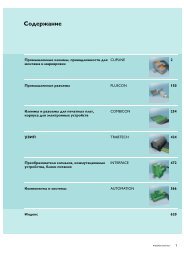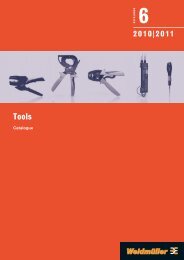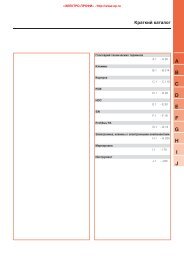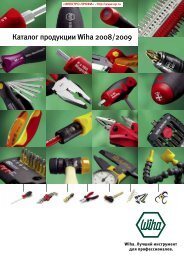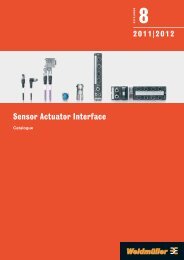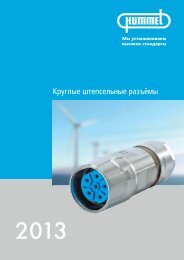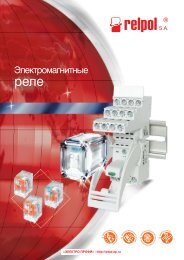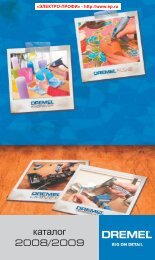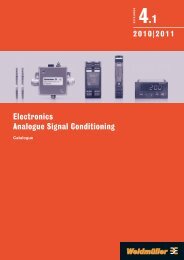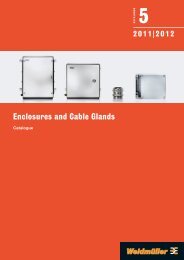- Page 1 and 2: C A T A L O G U E 3 2012|2013 RockS
- Page 3 and 4: C A T A L O G U E 3 RockStar ® - H
- Page 5 and 6: Product overview RockStar ® - Heav
- Page 7 and 8: Contents Overview HDC Overview HDC
- Page 9 and 10: Overview HDC Part codes for inserts
- Page 11 and 12: Overview HDC Overview of sizes 2, 5
- Page 13 and 14: Overview HDC Overview HDC A S4 S4/0
- Page 15 and 16: Overview HDC A 1282180000 - 2012/20
- Page 17 and 18: Overview HDC Overview of sizes 3, 4
- Page 19 and 20: Technical data Overview HDC An over
- Page 21 and 22: Technical data Overview HDC Overvie
- Page 23 and 24: Technical data Tightening torques a
- Page 25 and 26: Overview HDC Overview HDC Housing I
- Page 27 and 28: Overview HDC Part codes for housing
- Page 29 and 30: Overview HDC Part codes for housing
- Page 31: Overview HDC Panel cut-out Housings
- Page 35 and 36: Technical data Overview HDC The der
- Page 37 and 38: Technical data Overview HDC In orde
- Page 39 and 40: Technical data IP class of protecti
- Page 41 and 42: Technical data Chemical resistance
- Page 43 and 44: Contents RockStar ® inserts RockSt
- Page 45 and 46: Introduction Consistency One plasti
- Page 47 and 48: HA series - the slim connectors Roc
- Page 49 and 50: HA series - the slim connectors Hou
- Page 51 and 52: HA series - the slim connectors Hou
- Page 53 and 54: HA series - the slim connectors Hou
- Page 55 and 56: HA series - the slim connectors Hou
- Page 57 and 58: HA series - the slim connectors Hou
- Page 59 and 60: HA series - the slim connectors Hou
- Page 61 and 62: HE series - the universal connector
- Page 63 and 64: HE series - the universal connector
- Page 65 and 66: HE series - the universal connector
- Page 67 and 68: HE series - the universal connector
- Page 69 and 70: HE series - the universal connector
- Page 71 and 72: HE series - the universal connector
- Page 73 and 74: HE series - the universal connector
- Page 75 and 76: HEE series - high contact density R
- Page 77 and 78: HEE series - high contact density H
- Page 79 and 80: HEE series - high contact density H
- Page 81 and 82: HEE series - high contact density H
- Page 83 and 84:
HEE series - high contact density H
- Page 85 and 86:
HEE series - high contact density H
- Page 87 and 88:
HD series - the flexible connectors
- Page 89 and 90:
a b HD series - the flexible connec
- Page 91 and 92:
a b HD series - the flexible connec
- Page 93 and 94:
HD series - the flexible connectors
- Page 95 and 96:
HD series - the flexible connectors
- Page 97 and 98:
HD series - the flexible connectors
- Page 99 and 100:
HD series - the flexible connectors
- Page 101 and 102:
HD series - the flexible connectors
- Page 103 and 104:
HD series - the flexible connectors
- Page 105 and 106:
HD series - the flexible connectors
- Page 107 and 108:
HD series - the flexible connectors
- Page 109 and 110:
HD series - the flexible connectors
- Page 111 and 112:
HDD series - the compact connectors
- Page 113 and 114:
HDD series - the compact connectors
- Page 115 and 116:
HDD series - the compact connectors
- Page 117 and 118:
HDD series - the compact connectors
- Page 119 and 120:
HDD series - the compact connectors
- Page 121 and 122:
HDD series - the compact connectors
- Page 123 and 124:
HDD series - the compact connectors
- Page 125 and 126:
HVE series - exciting voltage RockS
- Page 127 and 128:
HVE series - exciting voltage Housi
- Page 129 and 130:
HVE series - exciting voltage Housi
- Page 131 and 132:
HVE series - exciting voltage Housi
- Page 133 and 134:
HSB series - the heavy-duty connect
- Page 135 and 136:
HSB series - the heavy-duty connect
- Page 137 and 138:
HSB series - the heavy-duty connect
- Page 139 and 140:
HQ series - the powerful little con
- Page 141 and 142:
HQ series - the powerful little con
- Page 143 and 144:
HQ series - the powerful little con
- Page 145 and 146:
HQ series - the powerful little con
- Page 147 and 148:
HQ series - the powerful little con
- Page 149 and 150:
HQ series - the powerful little con
- Page 151 and 152:
MixMate series - the high-capacity
- Page 153 and 154:
MixMate series - the high-capacity
- Page 155 and 156:
RockStar ® inserts B 1282180000 -
- Page 157 and 158:
MixMate series - the high-capacity
- Page 159 and 160:
MixMate series - the high-capacity
- Page 161 and 162:
MixMate series - the high-capacity
- Page 163 and 164:
MixMate series - the high-capacity
- Page 165 and 166:
MixMate series - the high-capacity
- Page 167 and 168:
MixMate series - the high-capacity
- Page 169 and 170:
MixMate series - the high-capacity
- Page 171 and 172:
MixMate series - the high-capacity
- Page 173 and 174:
MixMate series - the high-capacity
- Page 175 and 176:
MixMate series - the high-capacity
- Page 177 and 178:
MixMate series - the high-capacity
- Page 179 and 180:
Contents RockStar ® HighPower Rock
- Page 181 and 182:
Introduction RockStar ® HighPower
- Page 183 and 184:
RockStar ® HighPower RockStar ® H
- Page 185 and 186:
RockStar ® HighPower RockStar ® H
- Page 187 and 188:
RockStar ® HighPower C 1282180000
- Page 189 and 190:
RockStar ® HighPower RockStar ® H
- Page 191 and 192:
RockStar ® HighPower RockStar ® H
- Page 193 and 194:
Contents RockStar ® ConCept modula
- Page 195 and 196:
Introduction RockStar ® ConCept mo
- Page 197 and 198:
ConCept modules CM-HE Concept modul
- Page 199 and 200:
ConCept modules CM-5 Concept module
- Page 201 and 202:
ConCept modules CM-3 HV Technical d
- Page 203 and 204:
RockStar ® ConCept modular system
- Page 205 and 206:
ConCept bus modules RockStar ® Con
- Page 207 and 208:
ConCept bus modules Bus connector w
- Page 209 and 210:
ConCept bus modules Female contact
- Page 211 and 212:
RockStar ® ConCept modular system
- Page 213 and 214:
15.9 15.6 ConCept ST ConCept ST Mod
- Page 215 and 216:
ConCept pneumatic modules CM pneuma
- Page 217 and 218:
ConCept module frame Selection of H
- Page 219 and 220:
ConCept module frame Selection of H
- Page 221 and 222:
ConCept module frame Selection of H
- Page 223 and 224:
ConCept module frame Selection of H
- Page 225 and 226:
ConCept module frame Selection of H
- Page 227 and 228:
ConCept module frame Selection of H
- Page 229 and 230:
ConCept module frame Selection of H
- Page 231 and 232:
ConCept module frame Selection of H
- Page 233 and 234:
ConCept module frame Selection of H
- Page 235 and 236:
ConCept module frame Selection of H
- Page 237 and 238:
ModuFlex C Coupling frame Mounting
- Page 239 and 240:
RockStar ® Housings IP66 / NEMA Ty
- Page 241 and 242:
Introduction RockStar ® Housings I
- Page 243 and 244:
RockStar ® Housings IP66 / NEMA Ty
- Page 245 and 246:
Metal housing Size 1 Base Bulkhead
- Page 247 and 248:
Plastic housing Size HQ Base Bulkhe
- Page 249 and 250:
Die cast zinc housing (EMC) Size HQ
- Page 251 and 252:
RockStar ® Housings IP66 / NEMA Ty
- Page 253 and 254:
RockStar ® Housings IP66 / NEMA Ty
- Page 255 and 256:
RockStar ® Housings IP66 / NEMA Ty
- Page 257 and 258:
RockStar ® Housings IP66 / NEMA Ty
- Page 259 and 260:
RockStar ® Housings IP66 / NEMA Ty
- Page 261 and 262:
RockStar ® Housings IP66 / NEMA Ty
- Page 263 and 264:
RockStar ® Housings IP66 / NEMA Ty
- Page 265 and 266:
RockStar ® Housings IP66 / NEMA Ty
- Page 267 and 268:
RockStar ® Housings IP66 / NEMA Ty
- Page 269 and 270:
RockStar ® Housings IP66 / NEMA Ty
- Page 271 and 272:
RockStar ® Housings IP66 / NEMA Ty
- Page 273 and 274:
RockStar ® Housings IP66 / NEMA Ty
- Page 275 and 276:
RockStar ® Housings IP66 / NEMA Ty
- Page 277 and 278:
5 RockStar ® Housings IP66 / NEMA
- Page 279 and 280:
RockStar ® Housings IP66 / NEMA Ty
- Page 281 and 282:
RockStar ® Housings IP66 / NEMA Ty
- Page 283 and 284:
RockStar ® Housings IP66 / NEMA Ty
- Page 285 and 286:
RockStar ® Housings IP66 / NEMA Ty
- Page 287 and 288:
RockStar ® Housings IP66 / NEMA Ty
- Page 289 and 290:
Contents RockStar ® Housings IP68
- Page 291 and 292:
Introduction Practical Laser labell
- Page 293 and 294:
RockStar ® Housings IP68 Screw con
- Page 295 and 296:
6 RockStar ® Housings IP68 Screw c
- Page 297 and 298:
RockStar ® Housings IP68 Screw con
- Page 299 and 300:
6 RockStar ® Housings IP68 Screw c
- Page 301 and 302:
6 RockStar ® Housings IP68 Screw c
- Page 303 and 304:
Screw connection Size 8, XXL Base B
- Page 305 and 306:
RockStar ® Heat Trace Connector Co
- Page 307 and 308:
Introduction RockStar ® Heat Trace
- Page 309 and 310:
RockStar ® Data Connectors Content
- Page 311 and 312:
Introduction RockStar ® Data Conne
- Page 313 and 314:
Male contact carrier Designation Ty
- Page 315 and 316:
Housing selection RockStar ® IP66
- Page 317 and 318:
Screw connection Size 1 Base Bulkhe
- Page 319 and 320:
Flange RockStar ® V5 - RJ45 Module
- Page 321 and 322:
Flange inserts RJ45 • Cat.6 A •
- Page 323 and 324:
Contents RockStar ® Kits RockStar
- Page 325 and 326:
Introduction RockStar ® Kits Easy
- Page 327 and 328:
Kits with HA inserts, 3 pole 250 V,
- Page 329 and 330:
Kits with HA inserts, 4 pole 250 V,
- Page 331 and 332:
Kits with HE inserts, 6 pole 500 V,
- Page 333 and 334:
Kits with HE inserts, 6-pole, PUSH
- Page 335 and 336:
Kits with HE inserts, 10 pole 500 V
- Page 337 and 338:
Kits with HE inserts, 10-pole, PUSH
- Page 339 and 340:
Kits with HE inserts, 16 pole 500 V
- Page 341 and 342:
Kits with HE inserts, 16-pole, PUSH
- Page 343 and 344:
Kits with HE inserts, 24 pole 500 V
- Page 345 and 346:
Kits with HE inserts, 24-pole, PUSH
- Page 347 and 348:
Kits with HE inserts, 32 pole 500 V
- Page 349 and 350:
Kits with HE inserts, 48 pole 500 V
- Page 351 and 352:
Contents RockStar ® accessories Ro
- Page 353 and 354:
Introduction Secure Solid, machined
- Page 355 and 356:
Crimp contacts Crimp contacts for f
- Page 357 and 358:
Crimp contacts Crimp contacts for H
- Page 359 and 360:
Crimp contacts For CM-10 modules an
- Page 361 and 362:
Crimp contacts Instructions for ass
- Page 363 and 364:
Coding Coding system with guiding f
- Page 365 and 366:
Coding HE coding pin Use the HE cod
- Page 367 and 368:
7 7 7 Shield lever Shield lever for
- Page 369 and 370:
7 7 7 7 7 7 Shield lever for the Co
- Page 371 and 372:
Other accessories HDC GRIP PANEL 8
- Page 373 and 374:
F 19 Other accessories HDC screw ad
- Page 375 and 376:
Other accessories Profile seals Gas
- Page 377 and 378:
Content Tools Tools Tools Introduct
- Page 379 and 380:
Introduction Tools Cutting Practica
- Page 381 and 382:
Cutting Cable cutter KT 45 R •
- Page 383 and 384:
Stripping Stripping and cutting too
- Page 385 and 386:
Stripping Ordering data Type Conduc
- Page 387 and 388:
Stripping Sheathing stripper for co
- Page 389 and 390:
Crimping Crimping tool for wire end
- Page 391 and 392:
Crimping Stripping and crimping mac
- Page 393 and 394:
Crimping Pressing tool TT 8 RS MP 8
- Page 395 and 396:
Crimping Tools for polymer optical
- Page 397 and 398:
Screwdrivers VDE-insulated torque s
- Page 399 and 400:
Screwdrivers Uninsulated screwdrive
- Page 401 and 402:
Miscellaneous Crimp removal tools C
- Page 403 and 404:
Contents Cable entries Cable entrie
- Page 405 and 406:
Introduction Cable entries You shou
- Page 407 and 408:
Standard cable glands - Plastic Cab
- Page 409 and 410:
Standard cable glands - Brass Cable
- Page 411 and 412:
Standard cable glands - Brass Cable
- Page 413 and 414:
Standard cable glands - Brass Brass
- Page 415 and 416:
Standard cable glands - Brass Cable
- Page 417 and 418:
EMC cable glands Cable glands - Bra
- Page 419 and 420:
Cable glands for Ex applications -
- Page 421 and 422:
Accessories - Flat IP washers Flat
- Page 423 and 424:
Sealing plugs Sealing plugs - Plast
- Page 425 and 426:
Contents Identification systems Ide
- Page 427 and 428:
Introduction Identification systems
- Page 429 and 430:
Markers SM The SwitchMark marker ha
- Page 431 and 432:
Markers LM MT 300 - self-adhesive p
- Page 433 and 434:
Markers Wire and cable markers Iden
- Page 435 and 436:
Printers MCP Plus The plotter MCP P
- Page 437 and 438:
Printers MCP Identification systems
- Page 439 and 440:
Software M-Print ® PRO Label Desig
- Page 441 and 442:
Contents Weidmüller Services Weidm
- Page 443 and 444:
Weidmüller Services V 1282180000 -
- Page 445 and 446:
RockStar ® individual services Wei
- Page 447 and 448:
Customer specific solutions Individ
- Page 449 and 450:
Customer specific solutions Custome
- Page 451 and 452:
Customer specific solutions Weidmü
- Page 453 and 454:
Digital support Product assistant f
- Page 455 and 456:
Contents Index Index Index Index Ty
- Page 457 and 458:
Type Order No. Page Type Order No.
- Page 459 and 460:
Type Order No. Page Type Order No.
- Page 461 and 462:
Type Order No. Page Type Order No.
- Page 463 and 464:
Type Order No. Page Type Order No.
- Page 465 and 466:
Order No. Type Page Order No. Type
- Page 467 and 468:
Order No. Type Page Order No. Type
- Page 469 and 470:
Order No. Type Page Order No. Type
- Page 471 and 472:
Order No. Type Page Order No. Type
- Page 473 and 474:
Index / Order No. X 1282180000 - 20
- Page 475 and 476:
Index X 1282180000 - 2012/2013 X.21
- Page 477 and 478:
Group companies Agency abroad Witho
- Page 479:
www.weidmueller.com Argentina Austr



